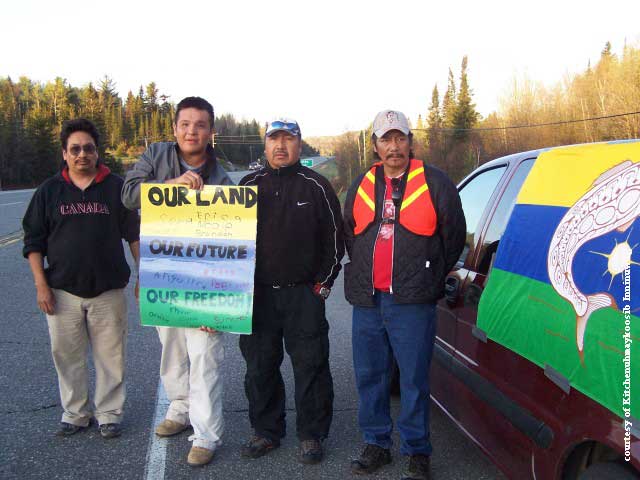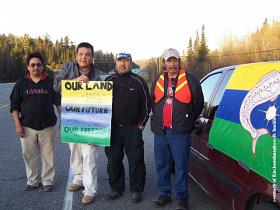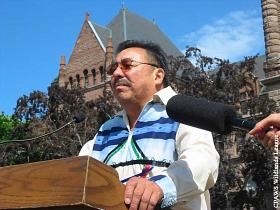RCMP hates on First Nations - Police State grows
TORONTO — The federal government created a wide-ranging surveillance network in early 2007 to monitor protests by First Nations, including those that would garner national attention or target “critical infrastructure” like highways, railways and pipelines, according to RCMP documents obtained through access to information requests.
Formed after the Conservatives came to power, the RCMP unit’s mandate was to collect and disseminate intelligence about situations involving First Nations that have “escalated to civil disobedience and unrest in the form of protest actions.”
According to an RCMP slideshow presentation from the spring of 2009, the intelligence unit reported weekly to approximately 450 recipients in law enforcement, government, and unnamed “industry partners” in the energy and private sector.
A RCMP spokesperson said the unit was never considered “permanent” and that last year it was “dismantled as it was determined to be no longer needed by its clients.” But the Mounties can’t say if the work is continuing in the field.
“Since the dismantling of the Aboriginal JIG [Joint Intelligence Group], the work done by the JIG is no longer performed at RCMP HQ Criminal Intelligence [CI]. However, we cannot confirm that RCMP divisions are not performing Aboriginal JIG activities under another name of program.”
An annual Strategic Intelligence Report, dated June 2009, indicates the surveillance at the time focused on eighteen “communities of concern” in five provinces across the country. These included First Nations in Ontario such as Kitchenuhmaykoosib Inninuwug (KI), Ardoch, Grassy Narrows, Six Nations and Tyendinaga, which have made headlines over the last few years for road and railway blockades and opposition to mining and logging on their territories.
The report states that the causes of unrest are “common issues” that could “seriously impact” Aboriginal peoples across the country—issues such as poverty, lack of funding for child and family services, and disputes over sovereignty, resource extraction and environmental concerns.
The so-called Aboriginal JIG that gathered the surveillance was run by the RCMP Criminal Intelligence branch and the RCMP’s National Security Criminal Investigations (NSCI), which has teams of officers in strategic locations across the country that deal with “threats to national security and criminal extremism or terrorism.”
It billed itself as a “central repository” of information about First Nations protest activities, assisted by an “extensive network of contacts throughout Canada and internationally” and an undisclosed number of field operatives acting as its “eyes and ears.”
The list of private sector businesses receiving weekly reports was chosen by the RCMP NSCI's Critical Infrastructure program, though the RCMP refused to share any of their names. Businesses also provided the intelligence unit with information about "current criminal threat environment for their facilities," according to the RCMP spokesperson.
Its yearly strategic intelligence report “identifies individuals who are causes of concern to public safety,” but any mentions of individuals were redacted in the copy obtained via access to information.
News of this RCMP surveillance comes on the heels of revelations that the Aboriginal Affairs ministry has spied on Cindy Blackstock, a long-time advocate for aboriginal children. In October it was also revealed that the Canadian military is keeping tabs on Aboriginal organizations. Alongside Aboriginal Affairs’ on-going “hot spots” surveillance, it suggests a massive, coordinated scaling-up of surveillance of Aboriginal peoples by the Harper government.
According to a previously obtained copy of a RCMP presentation to the Aboriginal Affairs Ministry in March 2007, the “vast majority” of the monitored protests and actions are “related to lands and resources,” and “most are incited by development activities on traditional territories” of First Nations.
As Canada has undergone a shift towards a more resource and especially energy based economy, industry has come increasingly into conflict with Aboriginal communities who claim rights over many of the lands exploited for mining, forestry and oil, and often oppose such development for environmental reasons.
The Mining Association of Canada has noted in a publication that “[m]ost mining activity occurs in northern and remote areas of the country, the principal areas of Aboriginal populations.”
The spectre of heightened Aboriginal protest has become a source of anxiety for government and industry.
An RCMP presentation to CSIS from April 2007 states, “There is a growing concern among high-level governmental officials and the policing community about the potential for unrest in Aboriginal communities, and an increasing sense of militancy among certain segments of the Aboriginal population.”
Recent political stand-offs have proved this concern to be prescient.
A high-profile $5.5 billion Enbridge pipeline that would carry tar sands oil to the Pacific through northern British Columbia has hit a wall of Indigenous opposition, whose “constitutional and legal position” former Cabinet minister Jim Prentice has called “very strong.” In the same province, the Tsilhqot’in Nation have to date blocked the controversial New Prosperity gold and copper mine, which would have turned a lake they consider sacred into a tailings dump.
In northern Ontario in 2008, the KI First Nation prevented Platinex from establishing a platinum mine on their traditional territory; Platinex's mining claim was eventually bought out for $5 million by the McGuinty government.
Comments
There are 0 comments on this post















